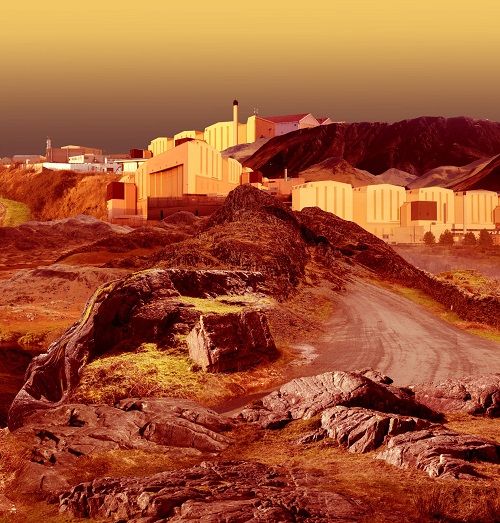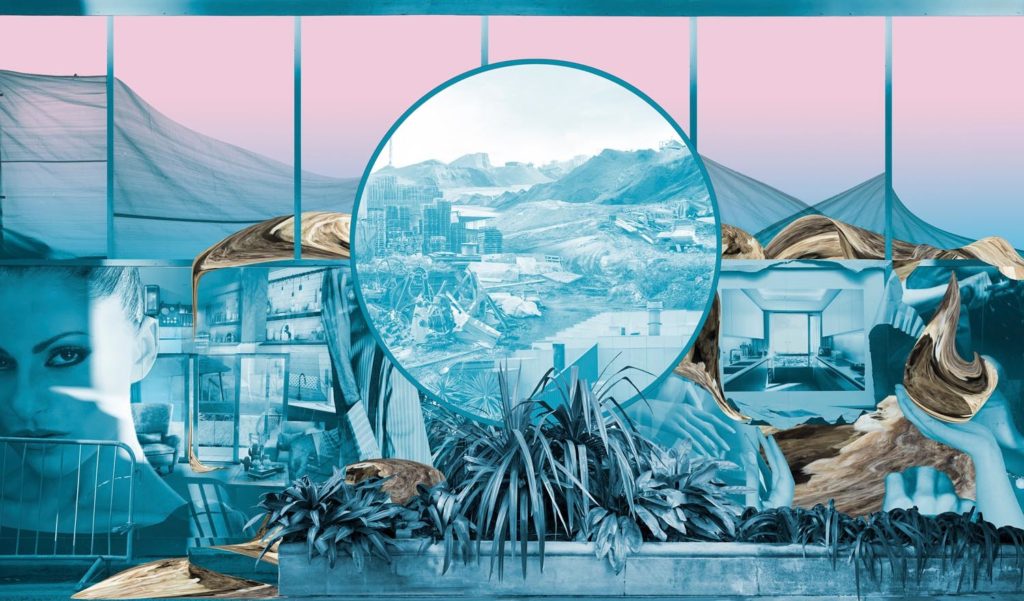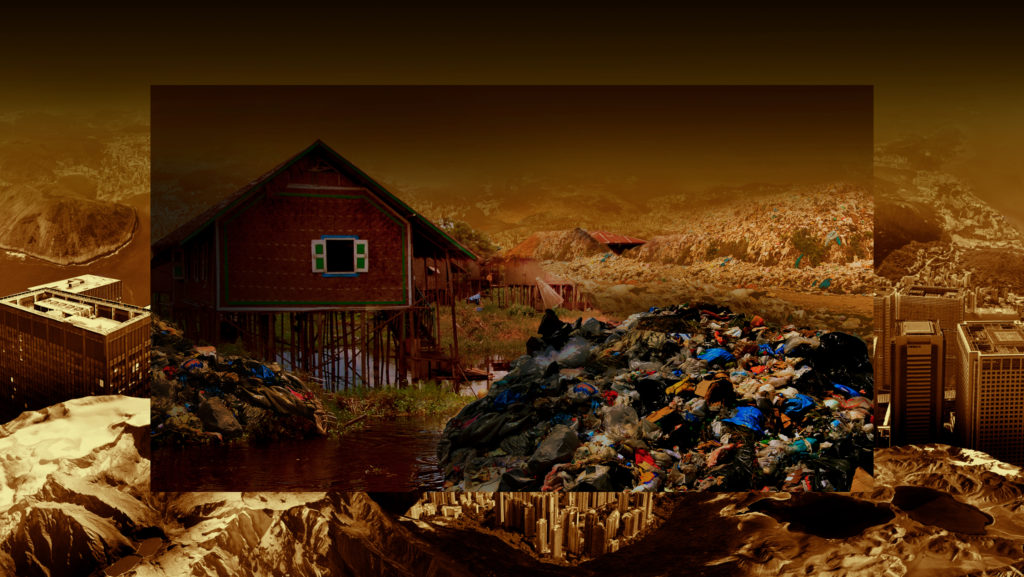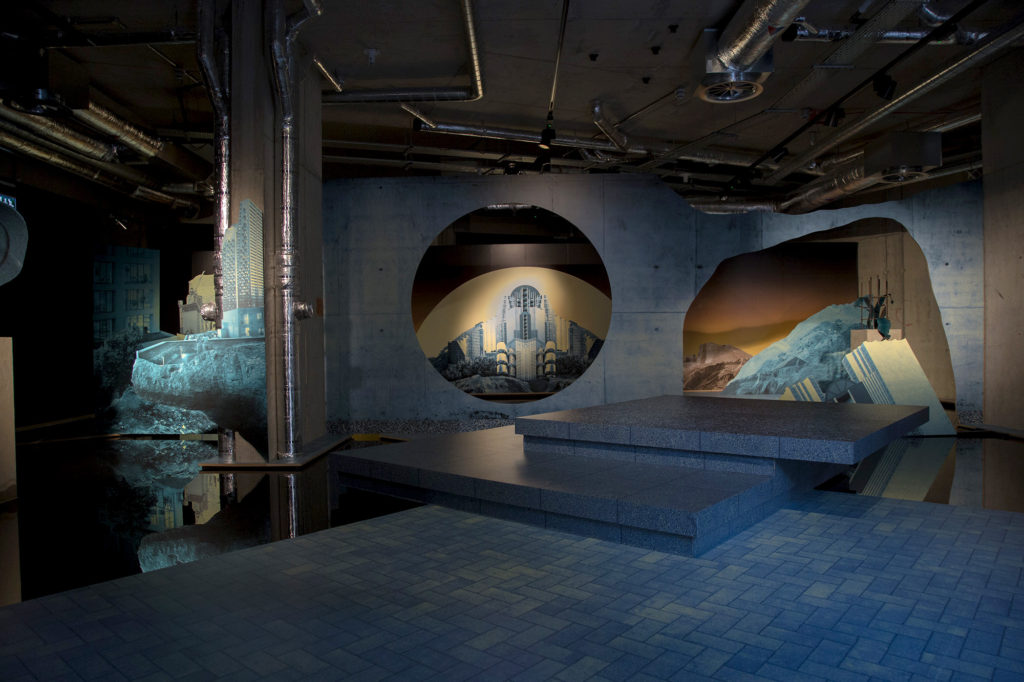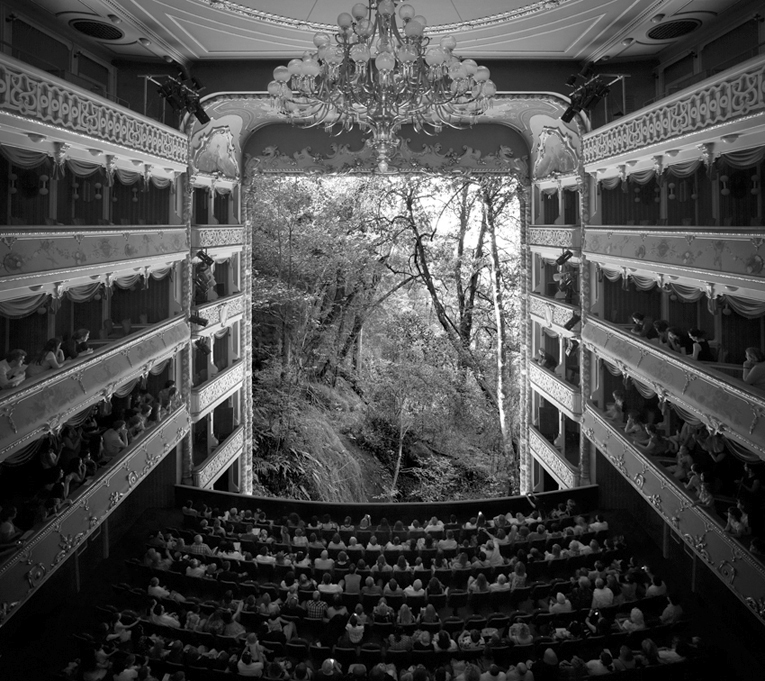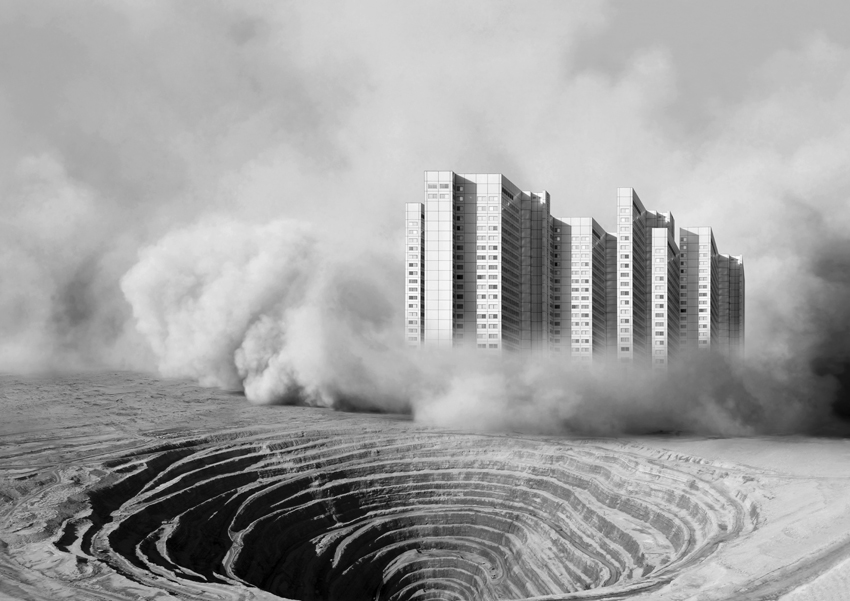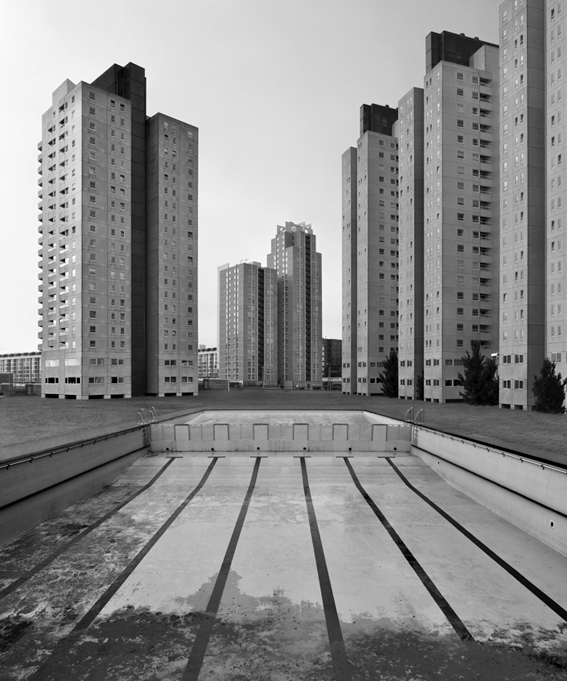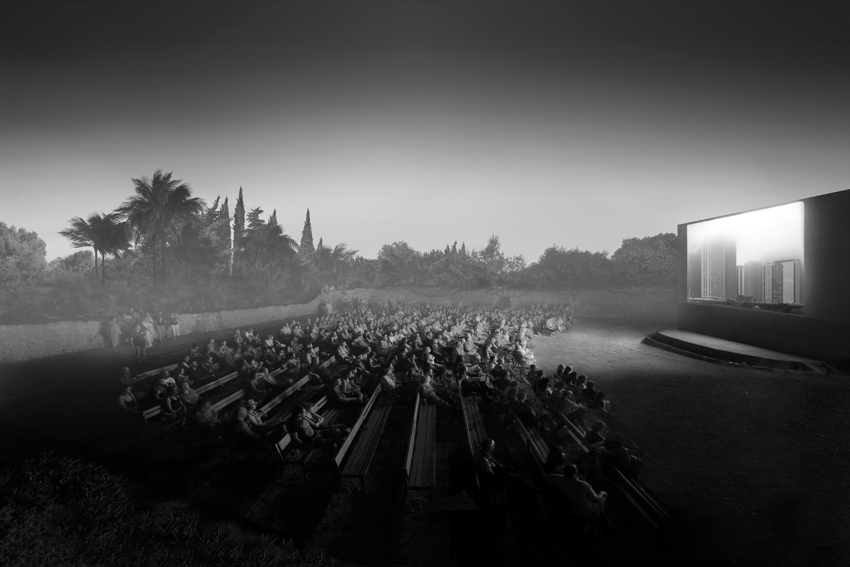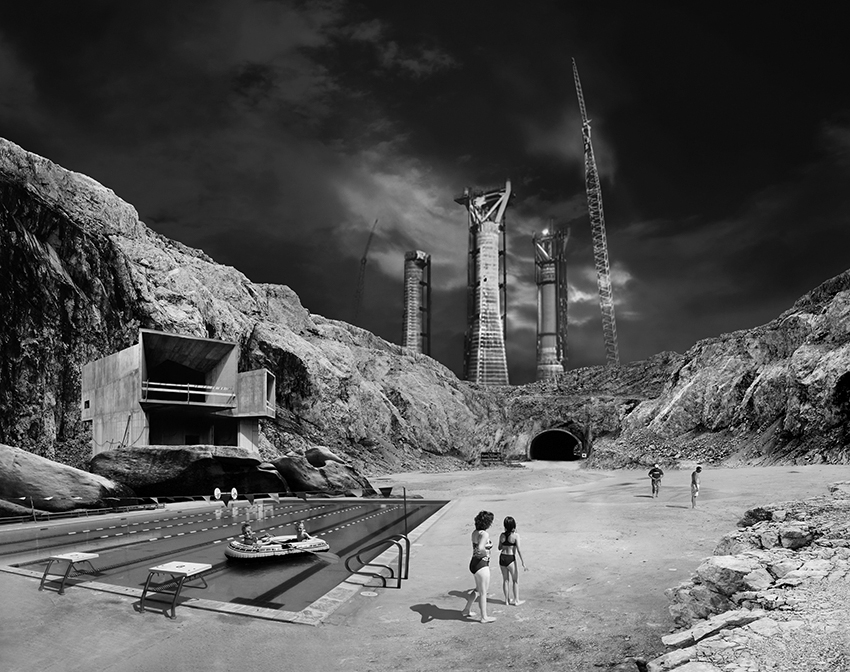Felicity Hammond
Felicity Hammond, a British artist based in London, is best known for her landscape photography, which fixates on the incessantly changing landscapes and the debris left behind. She creates her pieces through various methods, the most frequented being collage. Hammond has also been known to create video collages, that focus on the earth’s climate crises, such as her piece named ‘Lagoon’, depicting what rising sea levels would do to a city. First studying Fine Art Photography at the University of Gloucestershire in 2011, Hammond then went to earn her MA in Photography at the Royal College of Art in 2014. Presently, Hammond is a lecturer at Southampton Solent University, which she claims helps her to be constantly thinking about ‘the ever-changing boundaries within photography’.
Hammond usually displays her works in an installation manner rather than the traditional gallery. For example for her project named ‘In Defence of Industry’, Hammond presented her image in front of a large light box, and above a water feature on the floor reflecting her landscape.
Analysis
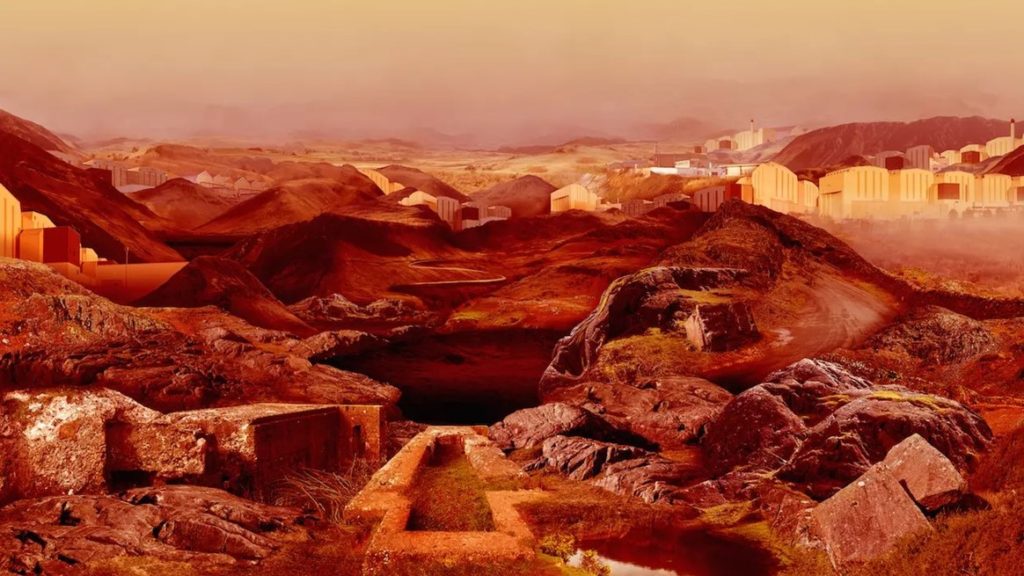
This altered landscape, created by Felicity Hammond, showcases a natural, rural landscape of hills and mountains, that has been invaded by large industrial structures. These beige and white incongruous buildings heavily contrast with the dark tone of the image and the shadows in between the hillsides. In addition, contrast in this piece can also be seen through the difference between the plain and boring tone of the industrial structures, and the rich and saturated hue this image possesses. The leading lines in this collage of images are presented through the ridges of the hills and mountains, as these peaks guide the viewers eye into the background, revealing more out of place structures hidden by the expanse of nature. Although these intrusive buildings look odd in such a rural setting, it can be argued that the focal point of this piece is the dark area of land in the middle, which appears to be a lake, due to it containing the darkest tone seen in the image and its central placement. Here Hammond also has appeared to apply the rule of thirds when taking the photograph for the natural landscape, as a result of the horizon line being located in the upper third of the image.
From a technical viewpoint, it can be said the natural landscape photograph was taken during the hours of sunrise or sunset due to the golden like sky in the background, and the dark orange tint, which may have been a mixture of natural lighting and digital editing by Hammond. This can also be said for the images needed for the buildings, as the front facing walls seem to be lit with the same golden glow. As a result of using natural lighting at this time, it is likely that Hammond used a medium ISO setting, making sure the photograph isn’t under or over exposed. The shutter speed used here was probably medium to fast, as there is no blur or evidence of movement, however the lens would have to be exposed to enough light to allow for a visible image. Furthermore, Hammond may have used a low aperture setting, meaning that the entirety of the rural landscape would possess the same amount of focus, allowing the viewer to explore the background of the image as much as the foreground.
Hammond created this altered landscape to display ‘the relationship between the industrial history of Barrow-in-Furness and the wider Cumbrian landscape’ in terms of its potential future with nuclear industry. Looking at this, it could be implied that here Hammond was aiming to bring attention to the issue revolving around the political side of the impact of nuclear industry. This may be referring to what could be at risk in the potential future, this being the natural landscapes surrounding this town and their need for defence.
Tanja Deman
Tanja Deman, born in 1982 Split, Croatia, is best known for her altered landscape pieces, which showcase the juxtaposition between nature and urban landscapes. These works are created through various mediums by Deman, such as photography, film, collage and public art installations. With these she aims to produce pieces that display the ‘dynamics hidden under the surface of both built and natural environment’. After graduating the Academy of Fine Arts in Zagreb, Croatia in 2006, Deman has found success and since gone on to exhibit her work, in various forms, in places such as the USA, Germany, the Netherlands, Italy, the UK and many more.
Analysis
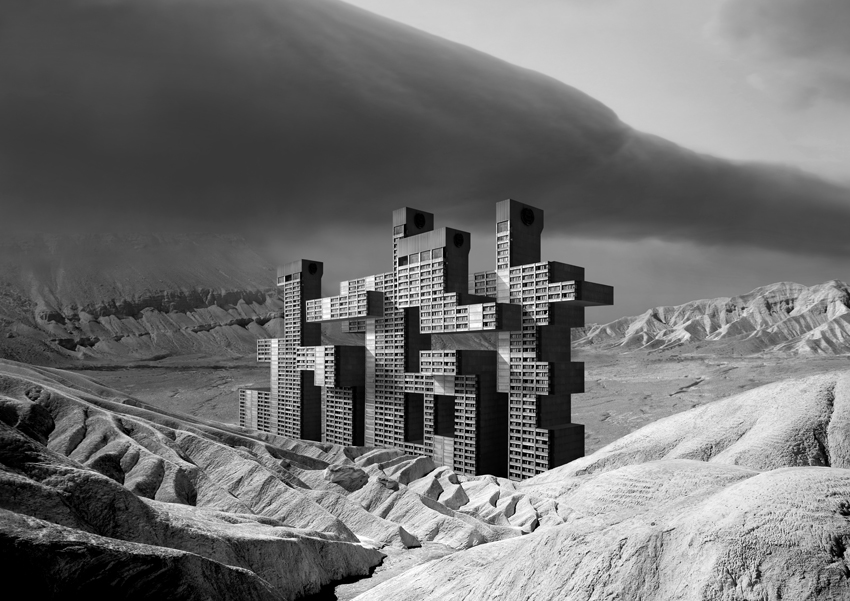
This black and white altered landscape created by Tanja Deman, displays a geometric urban structure surrounded by what appears to be a dry, desert like natural landscape. This dark, imposing building located in the centre of the image, causes a strong contrasts with the natural landscape, not just as it is the only man made structure visible, but also due to the fact it juxtaposes with the light tones of the encompassing hills and ridges. In addition, it can also be said that this contrast between light and dark is increased by Deman’s choice to produce this piece in black and white. It can be argued that this building is the image’s focal point, due to the central placement of the structure within the frame. Furthermore, the leading lines, which are created by peaks and ridges of the hills and mountains, guide the viewer’s eye across the image towards the focal point. It also seems that Deman has framed the photograph of the natural landscape, in order to create an enclosed piece of flat land in the centre, bordered by hills and mountains, in which the conflicting structure can be placed.
To look at this image technically, it can be said that to take the photographs required to produce this piece Deman most likely only used natural lighting at a time soon after midday. This can be seen through the harsh and angled shadows on the hillsides, and the dramatic clouds in the sky limiting the amount of sunlight. As a result of this, the ISO was presumably on a low to medium setting, allowing for the photographs to not be over exposed . Moreover, this also means that the shutter speed was probably on a fast setting, due to the large amounts of light flooding the lens and the lack of motion or blur visible in the piece. It appears tha Deman may have also used a low aperture here, as this broad landscape contains an even range of focus, meaning the viewer can see both the foreground and background clearly.
Taken from the project named ‘Fernweh’, Deman’s intention for this image, and the others in this series, was to showcase a visual representation of man’s incessant need to conquer and urbanise natural landscapes such as this, imposing its rational order on the land. This also explores what the consequences of these actions may lead to or have lead to, which is a constant desire for escapism within nature. With this, it could be implied that the Anthropocene era has been nature’s downfall, leading to the small areas it has been reduced to, becoming a place to escape our own creations.
Comparison
Whilst both pieces share the same outlook on the anthropic impact on nature and how it is becoming more and more scarce in modern day society, the two images differ and correspond in some areas from a visual standpoint.
Colour: The two altered landscapes differ in this area, as whilst Hammond’s piece is heavily saturated, Deman’s piece is black and white.
Lighting: In both images it is clear that natural lighting was used in order to capture the photographs needed to produce each piece, due to expansive settings of the landscapes.
Tone: It can be argued that Deman’s image presents an intense contrast between light and dark, whereas Hammond’s displays a more gentle tonal range due to its saturated, orange tint.
Line and Shape: The two landscapes coincide in the way that the leading lines created by the peaks and ridges of hills or mountains, however they differ when it comes to the shapes these lines create. This is as in Deman’s piece these lines are harsh, jagged and almost geometric in shape, whilst Hammond’s are more curved and gentle.
Composition: These two altered landscapes are dissimilar when it comes to the composition of the image, as Hammond has incorporated various incongruous structures throughout her natural landscape, located in both the foreground and background, unlike Deman who has focused on one singular building and framed it in the centre of the image.

